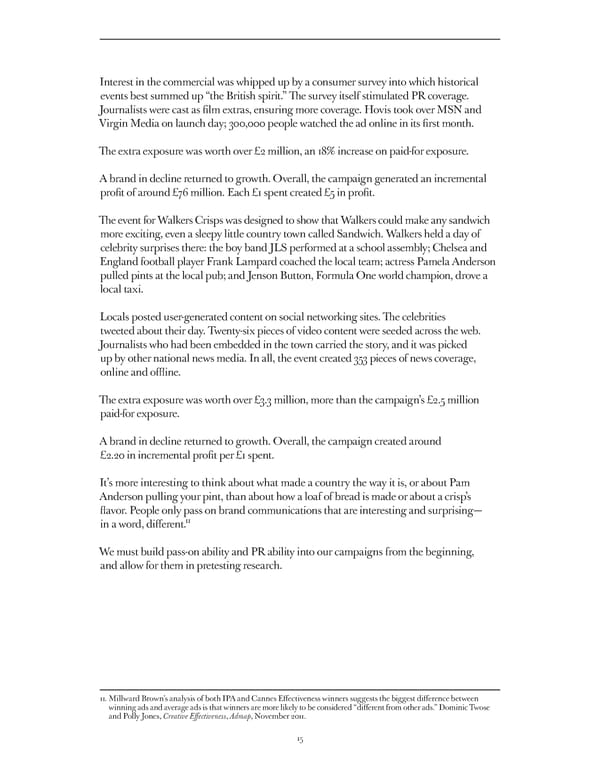Interest in the commercial was whipped up by a consumer survey into which historical events best summed up “the British spirit.” The survey itself stimulated PR coverage. Journalists were cast as film extras, ensuring more coverage. Hovis took over MSN and Virgin Media on launch day; 300,000 people watched the ad online in its first month. The extra exposure was worth over £2 million, an 18% increase on paid-for exposure. A brand in decline returned to growth. Overall, the campaign generated an incremental profit of around £76 million. Each £1 spent created £5 in profit. The event for Walkers Crisps was designed to show that Walkers could make any sandwich more exciting, even a sleepy little country town called Sandwich. Walkers held a day of celebrity surprises there: the boy band JLS performed at a school assembly; Chelsea and England football player Frank Lampard coached the local team; actress Pamela Anderson pulled pints at the local pub; and Jenson Button, Formula One world champion, drove a local taxi. Locals posted user-generated content on social networking sites. The celebrities tweeted about their day. Twenty-six pieces of video content were seeded across the web. Journalists who had been embedded in the town carried the story, and it was picked up by other national news media. In all, the event created 353 pieces of news coverage, online and offline. The extra exposure was worth over £3.3 million, more than the campaign’s £2.5 million paid-for exposure. A brand in decline returned to growth. Overall, the campaign created around £2.20 in incremental profit per £1 spent. It’s more interesting to think about what made a country the way it is, or about Pam Anderson pulling your pint, than about how a loaf of bread is made or about a crisp’s flavor. People only pass on brand communications that are interesting and surprising — 11 in a word, different. We must build pass-on ability and PR ability into our campaigns from the beginning, and allow for them in pretesting research. 11. Millward Brown’s analysis of both IPA and Cannes Effectiveness winners suggests the biggest difference between winning ads and average ads is that winners are more likely to be considered “different from other ads.” Dominic Twose and Polly Jones, Creative Effectiveness, Admap, November 2011. 15
 A Guide To Effectiveness Page 14 Page 16
A Guide To Effectiveness Page 14 Page 16